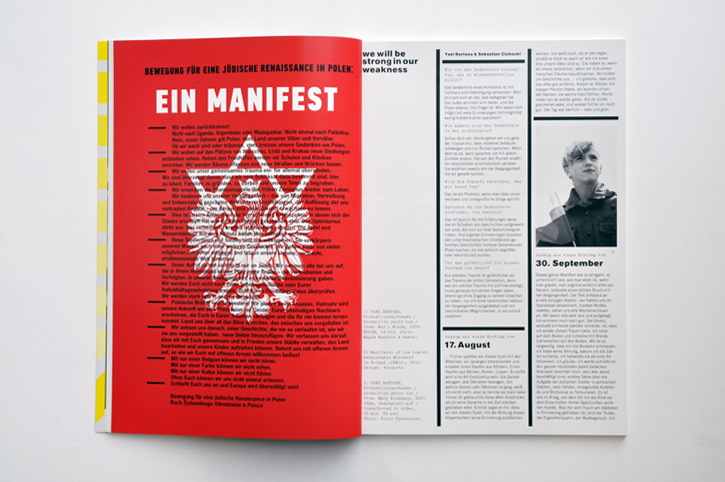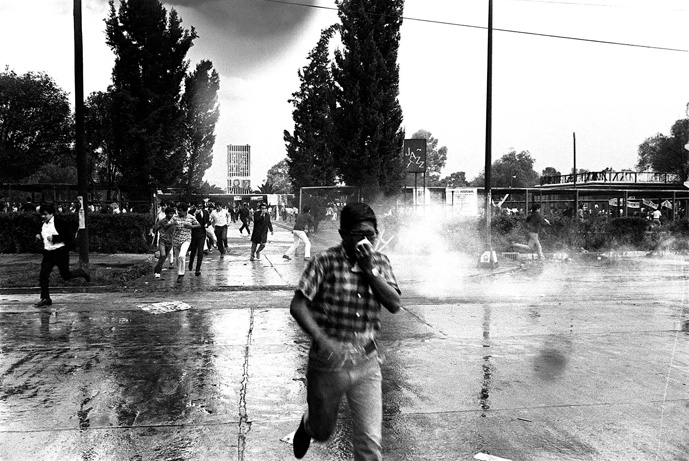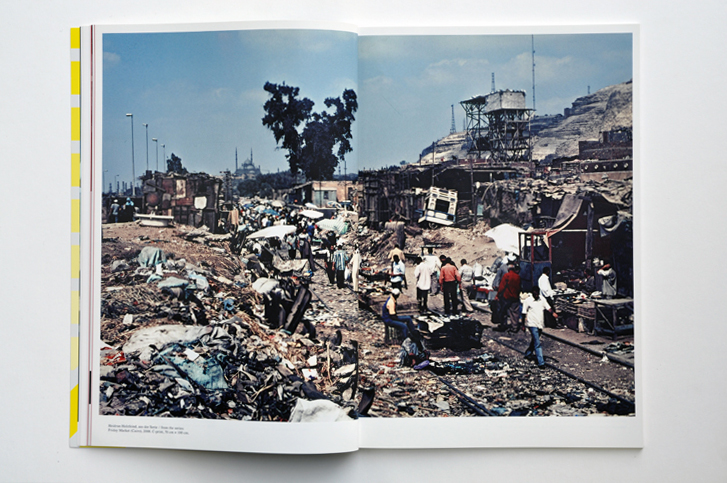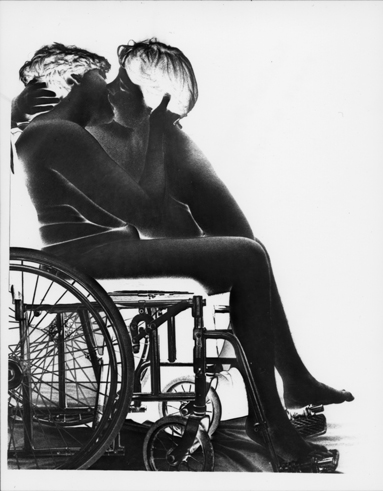Camera Austria International
113 | 2011
- TOM HOLERT
Sanja Iveković: On the Humming of the Community. On the Barricades - SANJA IVEKOVIC
- SEBASTIAN CICHOCKI
Yael Bartana: We Will Be Strong in Our Weakness - YAEL BARTANA
- RAIMAR STANGE
Heidrun Holzfeind: On the Inside of the Outside(r) 4 Fragments - HEIDRUN HOLZFEIND
- JULIA BRYAN-WILSON
Sharon Hayes - SHARON HAYES
- WALID SADEK
A Time to See 1/4 The Present of the Image
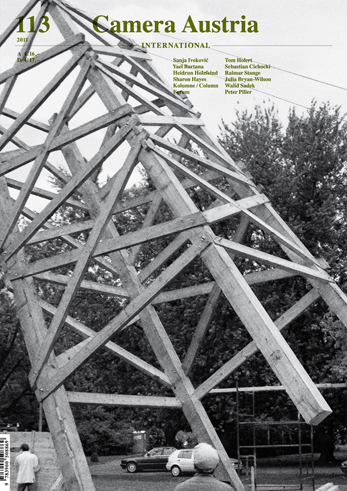
Preface
In an interview for Camera Austria International No. 107 (2009), Artur Żmijewski was asked about the discourse contexts in which he locates himself as producer of his radical documentary photographic and filmic images. He responded with a counter-question: “Which discourse should control my activity? Which one should criticise it?” Evident in this is an insistence on autonomy in the field of contemporary art, where the boundaries appear to be fixed, but are indeed newly negotiated again and again to the same extent by the actors moving in this field. What is programmatic about the work on our magazine and exhibition projects is not only newly probing the modes of using photography, but also newly sounding out our actions and our being-with-images again and again with critical reflection on our practices, and tying this into issues pointing beyond the field of art.
The current question of “community” is therefore the focal point not only of our exhibition programme in 2011, but is also reflected in the magazine. In two projects, “Communitas: The Unrepresentable Community” and “Communitas: Among Others”, we trace the growing social division of societies, the dominance of identitarian and exclusionary discourses. Many attempts to found presumably stable, manageable, community-like formations can be observed, which define themselves primarily by commonalities, but which in this way produce exposed “others”, who endanger and threaten these formations in their identity. Counter to these proposals of inclusion and exclusion, we want to make a thinking about being-common productive, which specifically does not insist on identity, which does not constantly produce fears of the “others”, a thinking that ultimately describes being-together as neither being-inside nor being-outside, but rather as being-side-by-side.
Camera Austria International 113 | 2011
Preface
In an interview for Camera Austria International No. 107 (2009), Artur Żmijewski was asked about the discourse contexts in which he locates himself as producer of his radical documentary photographic and filmic images. He responded with a counter-question: “Which discourse should control my activity? Which one should criticise it?” Evident in this is an insistence on autonomy in the field of contemporary art, where the boundaries appear to be fixed, but are indeed newly negotiated again and again to the same extent by the actors moving in this field. What is programmatic about the work on our magazine and exhibition projects is not only newly probing the modes of using photography, but also newly sounding out our actions and our being-with-images again and again with critical reflection on our practices, and tying this into issues pointing beyond the field of art.
The current question of “community” is therefore the focal point not only of our exhibition programme in 2011, but is also reflected in the magazine. In two projects, “Communitas: The Unrepresentable Community” and “Communitas: Among Others”, we trace the growing social division of societies, the dominance of identitarian and exclusionary discourses. Many attempts to found presumably stable, manageable, community-like formations can be observed, which define themselves primarily by commonalities, but which in this way produce exposed “others”, who endanger and threaten these formations in their identity. Counter to these proposals of inclusion and exclusion, we want to make a thinking about being-common productive, which specifically does not insist on identity, which does not constantly produce fears of the “others”, a thinking that ultimately describes being-together as neither being-inside nor being-outside, but rather as being-side-by-side.
Four of the artists participating in the exhibition projects—Yael Bartana, Sharon Hayes, Heidrun Holzfeind and Sanja Iveković—are presented in this issue of Camera Austria International. It seems to us that what they have in common is that they open up a political space with their methods and strategies, which actualises history in the present and goes beyond symbolising politics in the field of art.
With her manifesto calling for a Jewish renaissance in Poland, the Israeli artist Yael Bartana evokes the phantasm of an identitarian Jewish community. In doing so, by combining archive material with her own images, she pre-empts the propagandist image and signs politics of the Zionist movement as her own. For this issue she has created, incollaboration with the author Sebastian Cichoki, a contribution with an appellative character and multiple refractions at the text level and the graphic level, thus clearly claiming autonomy for itself. We are pleased that with this contribution we are able to provide an insight into Bartana’s project of the same name, which the artist will present this summer in the Polish Pavilion at the Biennale in Venice.
The contribution from Sharon Hayes and Julia Bryan-Wilson was also created as a collaborative project: they establish an “other” as the conventional discourse through images and conduct their dialogue out of the images themselves. “[It] is a way of stimulating fresh
ways of thinking oriented towards and through the visual; in part, lastly, a way to evidence the complex and intertwined genealogies that contribute to who we are as a writer and an artist. What are the ethics of thinking this way through images, ‘using’ them to conjure
thought, drawing out of and away from them, perhaps, arbitrary parallels?”
With her most recent work “On the Barricades” (2010), the Croatian artist and 2009 Camera Austria Award-winner Sanja Iveković has again erected one of her anti-monuments, which deal with the traumatic experience of escalating state violence and the state-ordered repression of these experiences: Iveković used portrait photographs of people killed by the military and police during the uprisings in Gwangju in May 1980 or who have been missing since then. Here she treats the question of how it is “possible to come to terms with the collective traumatic experience resulting from the direct connection of emancipation and self-empowerment in the experience of unimaginable own potential with paralysing powerlessness in the face of massive military repression”, as Tom Holert writes in his essay on the work.
In her documentary work Heidrun Holzfeind often uses methods of empirical social research. This is exemplified by her video interview with residents of “Colonnade Park” in Newark, a residential complex by Mies van der Rohe, which was completed in 1960. Holzfeind’s documentary work queries immanent architectural and social utopias by juxtaposing them with the partly dystopian world views of the residents. In his accompanying essay Raimar Stange describes these different perspectives of society and its problems, which engender the various views present in Holzfeind’s works, as artistic method and political query at the same time.
Finally, this issue also marks the beginning of the column by the Beirut based artist and author Walid Sadek, which he has entitled “A Time for Seeing”: breaking through fixed conventions of representation and modes of reception through seeing itself and through writing about seeing, leads him to questions of the representation of political events. His contributions thus address central issues of dealing with visual representations of time and/or politics and of the documentary as a political practice, with which we will also be concerned in the coming issues.
With the first edition of Camera Austria International in 2011, we are also pleased to be able to present a revised layout to you. Together with the book designer and typographer Till Gathmann we have worked through the now more than thirty-year history of the magazine with the aim of updating it and emphasising its classicality. We wanted to develop the special relation of text and image, of visual stringency and theoretical discourse. For this reason, the most obvious changes have to do with the structuring and the readability of the texts. At the same time, we have given more space to the pictures and partly detached them from the text. This is most clearly evident in the “Forum”, the platform for artists still largely unknown in the international context, who will be curated from now on mainly by artists themselves. In the present edition, Peter Piller agreed to undertake the selection.
The genuine position of Camera Austria International was established especially by Christine Frisinghelli and Manfred Willmann with the first edition in 1980 and has been constantly developed since then. In this way, the project Camera Austria with its manifold activities has become one of the most important platforms in the field of contemporary artistic photography in Europe. We intend to tie into this contribution to the profile of the debate on photography, in order to even more strongly emphasise this genuine position in the future. In this sense, the typographical revision is also to be understood as a signal that we do not intend to give way to manifestations that happen to be in fashion, but will continue to adhere to this specialisation. We continue to be committed to the photographic as a specific terrain within the image register of the present: insisting on precision in the debate, working in close cooperation with artists and authors, which leads to unusual visual contributions and to well founded treatment of the respective positions.
Maren Lübbke-Tidow, Reinhard Braun
March 2011
Entries
Forum
Presented by Peter Piller:
ANDRZEJ STEINBACH
ULRIKE HANNEMANN
MALWINE RAFALSKI
KNUT SENNEKAMP
BJÖRN SIEBERT
KLAUS PICHLER
Exhibitions
Hyper Real.
Die Passion des Realen in Malerei und Fotografie
MUMOK, Wien
Ludwig Forum für Internationale Kunst, Aachen
Ludwig Múzeum, Budapest
MARGIT NEUHOLD
Der Rote Bulli.
Stephen Shore und die Neue Düsseldorfer Fotografie
NRW- Forum, Düsseldorf
WOLFGANG VOLLMER
New Topographics
Landesgalerie Linz am Oberösterreichischen Landesmuseum, Linz
Die Photographische Sammlung / SK Stiftung Kultur, Köln
ESTHER RUELFS
Month of Photography
Paris
LUCIA PESAPANE
Geta Bratescu: Alteritate
Galerie Mezzanin, Wien
Matthias Herrmann: Privacy, Property, Photography, Paraphernalia
Galerie Steinek, Wien
Juergen Teller: Text und Bilder
Christine König Galerie, Wien
MANISHA JOTHADY
Hans–Peter Feldmann: An Art Exhibition
Museo Nacional Centro de Arte Reina Sofía
Madrid
ALBERTO MARTíN
Katarzyna Kozyra: Casting
Zachęta National Gallery of Art, Warsaw
KAROL SIENKIEWICZ
The Year of Russia in France
States of Artifice…
Etats de l´Artifice
Musée d´Art Moderne de la Ville de Paris
MICHÉLE COHEN HADRIA
Hilary Lloyd
Rawen Row, London
MARTIN HERBERT
Natalie Czech: Je n´ai rien à dire. Seulement à montrer
Galerie Katharina Bittel, Hamburg
KERSTIN BRANDES
Nan Goldin: Berlin Work
JULIA GWENDOLYN SCHNEIDER
Mark Morrisroe
Fotomuseum Winterthur
HANS-JÜRGEN HAFNER
Pictures by Women: A History of Modern Photography
The Museum of Modern Art, New York
RACHEL BAUM
David Goldblatt: TJ 1948 – 2010
Fondation Henri Cartier-Bresson
KERSTIN STREMMEL
Books
Not in Fashion. Mode und Fotografie der 90er Jahre
Kerber Verlag, Bielefeld 2010
CAROLIN FÖRSTER
Stephen Willats: Art Society Feedback
Badischer Kunstverein, Karlsruhe 2010
Verlag für moderne Kunst, Nürnberg 2010
BARBARA HESS
Subversive Praktiken / Practices. Kunst unter Bedingungen politischer Repression. 60er–80er / Südamerika / Europa
Hatje Cantz Verlag, Ostfildern 2010
CHRISTIAN HÖLLER
Leo Kandl: Free Portraits
Fotohof edition, Salzburg 2010
DANIELA BILLNER
Dance With Camera
ICA, University of Pennsylvania 2010
NAOKO KALTSCHMIDT
Katharina Sieverding: Testcuts. Projected Data Images
intermedia art institute (imai), Düsseldorf,
DuMont Buchverlag, Köln 2010
GISLIND NABAKOWSKI
Imprint
Publisher: Reinhard Braun
Owner: Verein CAMERA AUSTRIA. Labor für Fotografie und Theorie. Lendkai 1, 8020 Graz, Österreich
Editor-in-chief: Maren Lübbke-Tidow (V.i.S.d.P.)
Editors: Tanja Gassler, Margit Neuhold, Sabine Spilles
Translators: Aileen Derieg, John Doherty, Ewa Kaningowska-Gedroyc, Emilia Ligniti, Wilfried Prantner, Josephine Watson, Richard Watts
English proofreading: Dawn Michelle d´Atri, Aileen Derieg
Dank / Acknowledgements:
Yael Bartana, Stéphane Bauer, Jochen Becker, Kirsty Bell, Rainer Bellenbaum, Daniela Billner, Julia Bryan-Wilson, Peggy Buth, Sebastian Cichocki, Iris Dressler, Silvia Eiblmayr, Till Gathmann, Theresa Haigermoser, Hauser & Wirth, Sharon Hayes, Jon Hendricks, Tom Holert, Heidrun Holzfeind, Brigitte Huck, Sanja Iveković, Jochen Lempert, Susanna Kirschnik, Sandra Križić Roban, Peter Piller, Wolfgang Podbregar, P.P.O.W. Gallery (NY), Walid Raad, Marie Röbl, Emily Roysdon, Walid Sadek, Allison Smith, Special Collections and University Archives (Eugene), Raimar Stange, Adam Szymczyk, Friedrich Tietjen, Barbara Trautmann, Franz Vorraber, Maria Walter, Saskia Wendland, Hannah Wróblewska, Tobias Zielony, Artur Żmijewski
Copyright © 2011
Alle Rechte vorbehalten. Nachdruck nur mit vorheriger Genehmigung des Verlags. / All rights reserved. No parts of this magazine may be reproduced without publisher’s permission.
Für übermittelte Manuskripte und Originalvorlagen wird keine Haftung übernommen. / Camera Austria International does not assume any responsibility for submitted texts and original materials.
ISBN 978-3-900508-86-9
ISSN 1015-1915







